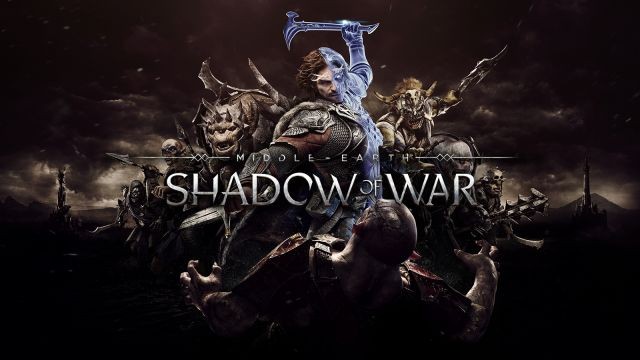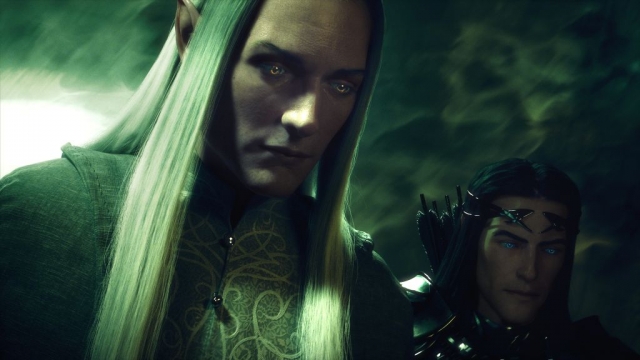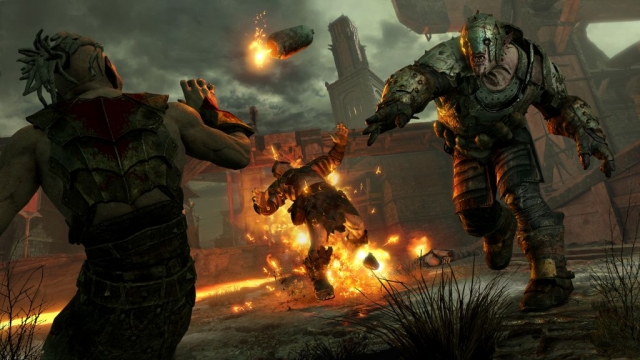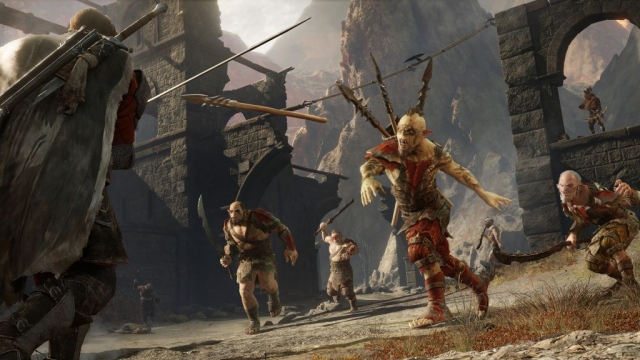Middle-earth: Shadow of War

The Good: Solid combat. Very nice graphics. So much stuff to do.
The Bad: Some of that stuff feels like filler. Several very long cutscenes full of overly-dramatic people murmuring or shouting. Somewhat easily gamed boss battles.
The Ugly: The worst minigames (?) ever devised.
Fun fact (at least for me): Middle Earth: Shadow of War is the first game that requires more than 100GB of hard drive space to install, or at least the first one I’ve run across. It’s all the high definition cutscenes, dozens of them, several of them quite long. I know I’ve made the observation in the past about how some games have so many long cutscenes that it is more like I’m watching it than playing it. Pieces of ME: SoW definitely have that vibe.
Anyway, I’ve gotta say, right off the bat, I’m not a big Tolkien fan. I saw the Peter Jackson films and liked them well enough, and I seem to recall reading The Hobbit back in the sixth grade or so, but I’ve never read Lord of the Rings or any of the other books. That said, I’ve played and enjoyed most of the videogames set in the Lord of the Rings universe, primarily for their gameplay, not their plotline. And so, in playing ME:SoW I have sort of skimmed along the surface of the story of the deceased ranger Talion and the spirit of elf lord Celebrimbor who shares his reanimated body, and their forging of a new ring of power. I don’t much care where it may or may not fit it the larger LotR canon or if it all threatens to break the Tolkien universe – I’m just there slaughtering orcs in a Batman-Dark-Knight-esque action adventure. I realize that there are others who are going to play as much or more for the plot than the gameplay, and that some of you may be upset with the direction this story takes. If you are one of those people who become so invested in a fictional universe where events there are sufficient to rile you up, I can’t help you. Try therapy. Oh, and Han shot first.
It’s been several years since I played Middle Earth: Shadow of Mordor, and there are doubtless many specifics I have forgotten about it, but I feel that, as a sequel, ME:SoW does mostly predictable things based upon ME:SoM. Let’s check off the boxes, shall we? Bigger map – check. Wider skill tree – check. More loot – check. Expanded repertoire of combat moves – check. Greater variation of mission types – check. Better graphics – check. Had ME:SoW done nothing more than this, I think I would still consider it a solid game, though I will admit that I’m biased – the open-world isometric acrobatic action brawler is one of my favorite genres. Heck, I even liked Arkham Knight (I was one of the lucky ones for whom it ran flawlessly from day one). As in the first game, Talion remains a whirling Ginsu blade of death, flipping, slashing, and kicking his way through a pack of orcs and savages and all manner of Tolkien bad guys. Better still, ME: SoW also adds a fair multiplayer component and an expansion of the nemesis system first introduced in ME:SoM.
The expanded combat moves give Talion area effect spells and a host of new ways to dish out punishment. The wider skill tree now allows you to somewhat customize him more to your play style, which nudges ME:SoW into the slightly blurrier genre of action-RPG, though I suspect hardcore RPG enthusiasts will find the change insufficiently enthralling to tear them away from Skyrim or Pillars of Eternity or whatever it is they’re playing these days. The loot system has gone kind of overboard – in almost every crowd you kill, someone drops something, sometimes several of them drop something. Ordinary grunts drop coins and a variety of gems. These gems can be slotted into weapons to add new effects such as increased damage or health or loot collection, or combined to create more powerful gems. Captains in Sauron’s army drop weapons and armor when they die – swords, daggers, bows, hoods, etc – the more powerful the captain, the higher level the loot. In just my first few hours of play, I had amassed dozens of gems and weapons. Thankfully there is no real inventory system – you can carry as much as you like. There has also been a lot of talk online about loot boxes that can be purchased using real-world money. I didn’t try them or even look at them, but I can say that as I played I never felt there was the need to grind significantly to get the weapons I needed, so I can’t answer charges I’ve seen levied in forums that the loot boxes represent a pay to win mechanic. Given that there are limited online competitive interactions, as I see it the people who buy them are only shortchanging themselves.
The nemesis system, for those of you who don’t remember it, involves the captains and warchiefs in Sauron’s army. They can be killed or subverted or maneuvered into grudge matches with other captains, spreading your influence and destabilizing the army. I remember playing almost a game within a game in ME:SoM, trying to see how much of the army command structure I could either kill or subvert. If one of these guys manages to kill you in combat or escape, they become your nemesis. Under the enhanced nemesis system, they gain a level and enhanced skills from the experience, and are tougher the next time around. It creates a nice little private war motif between you and specific captain, each time they appear becoming a little smarter and hardened to the tricks you used the previous time to defeat them. As a very low level character I stumbled into combat with a much higher level captain. I could have run away. Running away, even if only temporarily to heal, seems to always be a viable option because the captains don’t put up much of a chase. I see this as one of the greatest weaknesses of all captains; it makes the combat easier than it should be because of this lack of serious pursuit. Make a sneak attack, take a few swipes, run away, hide and heal up, make another sneak attack. If you choose to play that way, the combat rather quickly turns into drudgery. But I didn’t run away, and he killed me. The second time we met, I had learned from him, and beat him down only to have him escape at the last instant. For round three, I discovered that he had become arrow proof and would no longer allow me to vault over him – both tricks I had used to defeat him the previous time – it was I who barely managed to flee with my life. So went on the cat and mouse game with my nemesis.
Also under Nemesis 2.0, you can undertake a mission to assault a captain or warchief in his stronghold. These are a nice addition to the mission variety and often make for some good boss battles. Conquered captains and warchiefs now bring with them the soldiers they command into your fold, allowing you to build your own army and outfit a stronghold. Other players online can stage attacks with their armies upon your stronghold. I’ll admit that with 20+ hours into the game, and Wolfenstein II: The New Colossus sitting in my desk waiting to be reviewed, I haven’t fully explored this as much as I would like, but from what I’ve seen, it represents a whole different layer of the game. In the course of the single-player game, these armies can be used strategically to change the balance of forces on the game map, using conquered captains to assassinate other captains or infiltrate the ranks of warchief bodyguards. You can also go online to get vengeance against the nemeses of other players or they can come get vengeance against yours, which is both fun and very rewarding, though seems to only take place in a limited number of maps? The reason I say this is that I killed another player’s nemesis in a castle-like courtyard, and then the very next online nemesis mission I did took place in the exact same courtyard, same layout, with a different nemesis.
ME:SoW scores something of an intellectual coup with several of the most banal minigames of all time. I hesitate to even call them minigames – aren’t those supposed to be fun? In one, you bring blurry clues (like spirit footprints, or ghostly writing) into focus using WASD and the mouse. It only takes a few seconds typically, but there’s no clock you’re up against so that doesn’t matter. It is neither fun nor challenging, and there is simply no point to it. A second involves the towers on the map that have been converted to Sauron’s eyes. You can climb the towers to cleanse them (they then become fast travel points), and when you do you are given a view of the surrounding area and the sandbox missions contained in that area (as in Assassin’s Creed). You are also informed that there are memories(?) that can be located from the tower. This involves simply sweeping your view around until a circle appears indicating you are close to the spot of one of the memory locations, and then moving around until the circle gets smaller, and smaller, and finally you get the option to hit ‘x’ to mark the exact spot. These become merely other mission points you can then choose to visit in the area, and why they are not revealed as soon as you cleanse the tower and instead have to go through the silly scanning activity is beyond me. Yet another “minigame” has you assembling shattered fragments of memories until you can get them into alignment. It’s really hard to explain, and I had to go to two different forums to figure out what the heck I was supposed to be doing, and now that I know and can solve the puzzles in a few seconds, I’m still not sure I could explain it to someone else in words. I can say that it’s not fun. I’ll add to this paragraph the nearly endless antique doodads (a la Tomb Raider) and other collectables that the completists will no doubt consume hours collecting, but for the most part just offer a pleasing crowding of missions on the mission map, not actual gameplay.
From a quality perspective, ME:SoW lives up to AAA title expectations. Frame rates are smooth and fluid. The graphics are beautiful; both the architecture and character models are wonderfully detailed. When Talion climbs onto someone’s back and stabs them twenty times in the spine, you can’t help but cringe. The game is broken up into different regions which look distinctly different, even if they don’t play very different. The movies, with all the space they’re taking up, are nicely animated with top-rate voice work throughout. The game is not without glitches. Once I went into my inventory menu and all the text was way too large, the words cut off by their windows and the edges of the screen, but I closed the menu and reopened it, and all was well. I also noticed some clipping here and there, and sometimes had the character climb a wall or object they were near when I was trying to run in another direction entirely, or get stuck on some scenery feature unable to either climb or jump over it. I certainly haven’t come across anything I would consider game-breaking.
I’m enjoying Middle-earth: Shadow of War for the most part, even as it claims more than 5% of my available hard drive space. Monolith did for the most part choose the safe route by taking what Shadow of Mordor gave us and simply giving us more, some pieces blatantly lifted from other games, but the multiplayer component adds some fresh newness. I’d like to see the boss pursuit gameplay get a tune up, but we can’t have everything.
Reviewed By: Phil Soletsky
Publisher: Warner Bros. Interactive Entertainment
Rating: 80%
——————————————————————————–
This review is based on a digital copy of Middle-earth: Shadow of War for the PC provided by Warner Bros. Interactive Entertainment.
 Game Over Online
Game Over Online







